Snow leopard
| Snow leopard | |
|---|---|
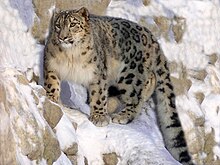
| |
Conservation status
| |
| Scientific classification | |
| Kingdom: | Animalia |
| Phylum: | Chordata |
| Class: | Mammalia |
| Order: | Carnivora |
| Suborder: | Feliformia |
| Family: | Felidae |
| Subfamily: | Pantherinae |
| Genus: | Panthera |
| Species: | P. uncia
|
| Binomial name | |
| Panthera uncia (Schreber, 1775)
| |

| |
| Distribution of the snow leopard, 2017[1] | |
| Synonyms | |
| |
The snow leopard (Panthera uncia), also known as the ounce, is a felid in the genus Panthera native to the mountain ranges of Central and South Asia. It is listed as Vulnerable on the IUCN Red List because the global population is estimated to number fewer than 10,000 mature individuals and is expected to decline about 10% by 2040. It is threatened by poaching and habitat destruction following infrastructural developments. It inhabits alpine and subalpine zones at elevations from 3,000 to 4,500 m (9,800 to 14,800 ft), ranging from eastern Afghanistan, the Himalayas and the Tibetan Plateau, to southern Siberia, Mongolia and western China. In the northern part of its range, it also lives at lower elevations.[2]
Taxonomically, the snow leopard was long classified in the monotypic genus Uncia.[3] Since phylogenetic studies revealed the relationships among Panthera species, it has been considered a member of that genus. Two subspecies were described based on morphological differences, but genetic differences between the two have not been confirmed. It is therefore regarded as a monotypic species.
Naming and etymology
Both the Latin name uncia and the English word ounce are derived from the Old French once, which was also used for the Eurasian lynx (Lynx lynx). Once is thought to have evolved from an earlier variant of lynx by false splitting; lonce was interpreted as l'once, in which l' is the elided form of the French definite article la ('the'), leaving once to be perceived as the animal's name.[4] The word panther derives from the classical Latin panthēra, itself from the ancient Greek πάνθηρ pánthēr, which was used for spotted cats.[5]
Taxonomy and evolution
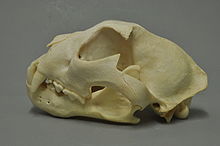
Felis uncia was the scientific name used by Johann Christian Daniel von Schreber in 1777 who described a snow leopard based on an earlier description by Georges-Louis Leclerc, Comte de Buffon, assuming that the cat occurred along the Barbary Coast, in Persia, East India and China.[6] The genus name Uncia was proposed by John Edward Gray in 1854 for Asian cats with a long and thick tail.[7] Felis irbis proposed by Christian Gottfried Ehrenberg in 1830 was a skin of a female snow leopard collected in the Altai Mountains. He also clarified that several leopard (P. pardus) skins were previously misidentified as snow leopard skins.[8] Felis uncioides proposed by Thomas Horsfield in 1855 was a snow leopard skin presented to the Museum of the East India Company.[9]
Uncia uncia was used by Reginald Innes Pocock in 1930 when he reviewed skins and skulls of Panthera species from Asia. He also described morphological differences between snow leopard and leopard skins.[10]
The snow leopard was subordinated to the genus Panthera based on results of phylogenetic studies.[11][12][13][14]
Panthera baikalensis-romanii proposed by a Russian scientist in 2000 was a dark brown snow leopard skin from the Petrovsk-Zabaykalsky District in southern Transbaikal.[15] Until spring 2017, there was no evidence available for the recognition of subspecies. Results of a phylogeographic analysis indicate that three subspecies should be recognised:[16]
- P. u. uncia in the range countries of the Pamir Mountains
- P. u. irbis in Mongolia, and
- P. u. uncioides in the Himalayas and Qinghai.
This view has been both contested and supported by different researchers.[17][18][19][20]
Evolution
Based on phylogenetic analysis of DNA sequence sampled across the living Felidae, the snow leopard forms a sister group with the tiger (P. tigris). Genetic divergence time of this group is estimated at 4.62 to 1.82 million years ago.[11][21] The snow leopard and the tiger probably diverged between 3.7 to 2.7 million years ago.[12] Panthera originates most likely in northern Central Asia. Panthera blytheae excavated in western Tibet's Ngari Prefecture is the oldest known Panthera species and exhibits skull characteristics similar to the snow leopard.[23]
The mitochondrial genomes of the snow leopard, the leopard and the lion (P. leo) are more similar to each other than their nuclear genomes, indicating that their ancestors hybridised at some point in their evolution.[24]
Characteristics
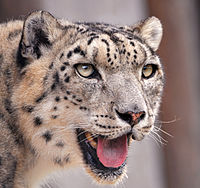

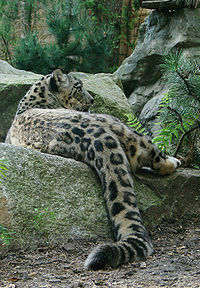
The snow leopard's fur is whitish to grey with black spots on head and neck, with larger rosettes on the back, flanks and bushy tail. The belly is whitish. Its eyes are pale green or grey in color. Its muzzle is short and its forehead domed. Its nasal cavities are large. The fur is thick with hairs between 5 and 12 cm (2 and 4+1⁄2 in) long. Its body is stocky, short-legged, and slightly smaller than the other cats of the genus Panthera, reaching a shoulder height of 56 cm (22 in), and ranging in head to body size from 75 to 150 cm (30 to 59 in). Its tail is 80 to 105 cm (31 to 41 in) long.[25] It weighs between 22 and 55 kg (49 and 121 lb), with an occasional large male reaching 75 kg (165 lb), and small female of under 25 kg (55 lb).[26] Its canine teeth are 28.6 mm (1+1⁄8 in) long and are more slender than those of the other Panthera species.[27] In relation to the length of its skull and width of its palate, it has large nasal openings, which allow for increasing the volume of air inhaled with each breath, and at the same time for warming and humidifying cold dry air.[28] It is not especially adapted to high-altitude hypoxia.[29]
The snow leopard shows several adaptations for living in a cold, mountainous environment. Its small rounded ears help to minimize heat loss. Its broad paws well distribute the body weight for walking on snow, and have fur on their undersides to increase the grip on steep and unstable surfaces; it also helps to minimize heat loss. Its long and flexible tail helps to maintain balance in the rocky terrain. The tail is also very thick due to fat storage, and is covered in a thick layer of fur, which allows the cat to use it like a blanket to protect its face when asleep.[30]
The snow leopard differs from the other Panthera species by a shorter muzzle, an elevated forehead, a vertical chin and a less developed posterior process of the lower jaw.[10] It cannot roar despite its partly ossified hyoid bone, as its 9 mm (3⁄8 in) short vocal folds provide little resistance to airflow.[31][32]
Distribution and habitat

The snow leopard is distributed from the west of Lake Baikal through southern Siberia, in the Kunlun Mountains, Altai Mountains, Sayan and Tannu-Ola Mountains, in the Tian Shan, through Tajikistan, Kyrgyzstan, Uzbekistan and Kazakhstan to the Hindu Kush in eastern Afghanistan, Karakoram in northern Pakistan, in the Pamir Mountains, the Tibetan Plateau and in the high elevations of the Himalayas in India, Nepal and Bhutan. In Mongolia, it inhabits the Mongolian and Gobi Altai Mountains and the Khangai Mountains. In Tibet, it occurs up to the Altyn-Tagh in the north.[33][34] Potential snow leopard habitat in the Indian Himalayas is estimated at less than 90,000 km2 (35,000 sq mi) in Jammu and Kashmir, Ladakh, Uttarakhand, Himachal Pradesh, Sikkim and Arunachal Pradesh, of which about 34,000 km2 (13,000 sq mi) is considered good habitat, and 14.4% is protected. In the beginning of the 1990s, the Indian snow leopard population was estimated at roughly 200–600 individuals living across about 25 protected areas.[34]
In summer, the snow leopard usually lives above the tree line on alpine meadows and in rocky regions at elevations from 2,700 to 6,000 m (8,900 to 19,700 ft). In winter, it descends to elevations around 1,200 to 2,000 m (3,900 to 6,600 ft). It prefers rocky, broken terrain, and can move in 85 cm (33 in) deep snow, but prefers to use existing trails made by other animals.[26]
Snow leopards were recorded by camera traps at 16 locations in northeastern Afghanistan's isolated Wakhan Corridor.[35]
Behavior and ecology
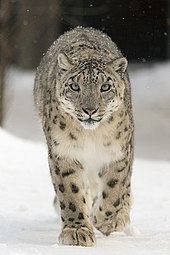
The snow leopard's vocalizations include meowing, grunting, prusten and moaning. It can purr when exhaling.[25]
It is solitary and active mostly at dawn until early morning, and again in afternoons and early evenings. It mostly rests near cliffs and ridges that provide vantage points and shade. In Nepal's Shey Phoksundo National Park, the home ranges of five adult radio-collared snow leopards overlapped largely, though they rarely met. Their individual home ranges ranged in size from 12 to 39 km2 (4.6 to 15.1 sq mi). Males moved between 0.5 and 5.45 km (5⁄16 and 3+3⁄8 mi) per day, and females between 0.2 and 2.25 km (1⁄8 and 1+3⁄8 mi), measured in straight lines between survey points. Since they often zigzagged in the precipitous terrain, they actually moved up to 7 km (4+1⁄2 mi) in a single night.[36] Up to 10 individuals inhabit an area of 100 km2 (40 sq mi); in habitats with sparse prey, an area of 1,000 km2 (400 sq mi) supports only five individuals.[37]
A study in the Gobi Desert lasting from 2008 to 2014 revealed that adult male snow leopards used a mean home range of 144–270 km2 (56–104 sq mi), while adult females ranged in areas of 83–165 km2 (32–64 sq mi). Their home ranges overlapped less than 20%. These results indicate that about 40% of the 170 protected areas in snow leopard range countries are smaller than the home range of a single male snow leopard.[38]
Snow leopards leave scent marks to indicate their territories and common travel routes. They scrape the ground with the hind feet before depositing urine or feces, but also spray urine onto rocks.[26] Their urine contains many characteristic low molecular weight compounds with diverse functional groups including pentanol, hexanol, heptanol, 3-octanone, nonanal and indole, which possibly play a role in chemical communication.[39]
Hunting and diet

In Hemis National Park, a snow leopard was observed while approaching prey from above, using rocky cliffs for cover; at a distance of about 40 m (130 ft) from the prey, it walked rapidly for about 15 m (49 ft), ran the last 25 m (82 ft) and killed the prey with a neck bite. While squatting on its haunches, it ripped out clumps of hair from the abdomen and then opened it to first feed on the viscera.[40] The snow leopard is a carnivore and actively hunts its prey. Its preferred wild prey species are Himalayan blue sheep (Pseudois nayaur), Himalayan tahr (Hemitragus jemlahicus), argali (Ovis ammon), markhor (Capra falconeri) and wild goat (C. aegagrus). It also preys on domestic livestock.[41] It prefers prey ranging in weight from 36 to 76 kg (79 to 168 lb), but also hunts smaller mammals such as Himalayan marmot (Marmota himalayana), pika and vole species. Its diet depends on prey availability and varies across its range and season. In the Himalayas, it preys mostly on Himalayan blue sheep, Siberian ibex (C. sibirica), white-bellied musk deer (Moschus leucogaster) and wild boar (Sus scrofa). In the Karakoram, Tian Shan, Altai and Mongolia's Tost Mountains, its main prey consists of Siberian ibex, Thorold's deer (Cervus albirostris), Siberian roe deer (Capreolus pygargus) and argali.[42][43] Snow leopard feces collected in northern Pakistan also contained remains of rhesus macaque (Macaca mulatta), masked palm civet (Paguma larvata), Cape hare (Lepus capensis), house mouse (Mus musculus), Kashmir field mouse (Apodemus rusiges), grey dwarf hamster (Cricetulus migratorius) and Turkestan rat (Rattus pyctoris).[44] In 2017, a snow leopard was photographed carrying a freshly killed woolly flying squirrel (Eupetaurus cinereus) near Gangotri National Park.[45] In Mongolia, domestic sheep comprises less than 20% of snow leopard diet, although wild prey has been reduced and interactions with people are common.[43]
Snow leopards actively pursue prey down steep mountainsides, using the momentum of their initial leap to chase animals for up to 300 m (980 ft). They drag the prey to a safe location and consume all edible parts of the carcass. They can survive on a single Himalayan blue sheep for two weeks before hunting again, and one adult individual apparently needs 20–30 adult blue sheep per year.[1][26] Snow leopards have been recorded to hunt successfully in pairs, especially mating pairs.[46]
The snow leopard is capable of killing most animals in its range, with the probable exception of the adult male yak. It also eats a significant amount of vegetation, including grass and twigs. It has not been reported to attack humans, is easily driven away from livestock and readily abandons kills, often without defending itself.[26]
Reproduction and life cycle

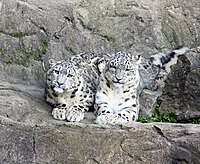

Snow leopards become sexually mature at two to three years, and normally live for 15–18 years in the wild. In captivity they can live for up to 25 years. Oestrus typically lasts from five to eight days, and males tend not to seek out another partner after mating, probably because the short mating season does not allow sufficient time. Paired snow leopards mate in the usual felid posture, from 12 to 36 times a day. They are unusual among large cats in that they have a well-defined birth peak. They usually mate in late winter, marked by a noticeable increase in marking and calling. Females have a gestation period of 90–100 days, and the cubs are born between April and June.[26] A litter usually consists of two to three cubs, in exceptional cases also up to seven.[33]
The female gives birth in a rocky den or crevice lined with fur shed from her underside. The cubs are blind and helpless at birth, although already with a thick coat of fur, and weigh from 320 to 567 g (11+5⁄16 to 20 oz). Their eyes open at around seven days, and the cubs can walk at five weeks and are fully weaned by 10 weeks. The cubs leave the den when they are around two to four months of age.[26] Three radio-collared snow leopards in Mongolia’s Tost Mountains gave birth between late April and late June. Two female cubs started to part from their mothers at the age of 20 to 21 months, but reunited with them several times for a few days over a period of 4–7 months. One male cub separated from its mother at the age of about 22 months, but stayed in her vicinity for a month and moved out of his natal range at 23 months of age.[47]
The snow leopard has a generation length of eight years.[48]
Threats
The major threat to snow leopard populations is poaching and illegal trade of skins and body parts.[1] Between 1999 and 2002, three live snow leopard cubs and 16 skins were confiscated, 330 traps were destroyed and 110 poachers were arrested in Kyrgyzstan. Undercover operations in the country revealed an illegal trade network with links to Russia and China via Kazakhstan. The major skin trade center in the region is the city of Kashgar in Xinjiang.[49] In Tibet and Mongolia, skins are used for traditional dresses, and meat in traditional Tibetan medicine to cure kidney problems; bones are used in traditional Chinese and Mongolian medicine for treating rheumatism, injuries and pain of human bones and tendons. Between 1996 and 2002, 37 skins were found in wildlife markets and tourist shops in Mongolia.[50] Between 2003 and 2016, 710 skins were traded, of which 288 skins were confiscated. In China, 103 to 236 animals are poached every year, in Mongolia between 34 and 53, in Pakistan between 23 and 53, in India from 21 to 45, and in Tajikistan 20 to 25. In 2016, a survey of Chinese websites revealed 15 advertisements for 44 snow leopard products; the dealers offered skins, canine teeth, claws and a tongue.[51] Nine snow leopard skins were found during a market survey in September 2014 in Afghanistan.[52]
Greenhouse gas emissions will likely cause a shift of the treeline in the Himalayas and a shrinking of the alpine zone, which may reduce snow leopard habitat by 30%.[53]
Where snow leopards prey on domestic livestock, they are subject to conflict with humans.[1] The loss of natural prey due to overgrazing by livestock, poaching, and defense of livestock are the major drivers for the decreasing population of the snow leopard.[26]
Conservation
| Country | Year | Estimate |
|---|---|---|
| Afghanistan | 2016 | 50–200[54] |
| Bhutan | 2016 | 79–112[55] |
| China | 2016 | 4,500[56] |
| India | 2016 | 516–524[57] |
| Kazakhstan | 2016 | 100–120[58] |
| Kyrgyzstan | 2016 | 300–400[59] |
| Mongolia | 2016 | 1,000[60] |
| Nepal | 2016 | 301–400[61] |
| Pakistan | 2016 | 250-420[62] |
| Russia | 2016 | 70–90[63] |
| Tajikistan | 2016 | 250–280[64] |
| Uzbekistan | 2016 | 30–120[65] |
The snow leopard is listed in CITES Appendix I.[66] It has been listed as threatened with extinction in Schedule I of the Convention on the Conservation of Migratory Species of Wild Animals since 1985.[50] Hunting snow leopards has been prohibited in Kyrgyzstan since the 1950s.[49] In India, the snow leopard is granted the highest level of protection under the Wildlife Protection Act, 1972, and hunting is sentenced with imprisonment of 3–7 years.[57] In Nepal, it has been legally protected since 1973, with penalties of 5–15 years in prison and a fine for poaching and trading it.[67] Since 1978, it has been listed in the Soviet Union’s Red Book and is still inscribed today in the Red Data Book of the Russian Federation as threatened with extinction. Hunting snow leopards is only permitted for the purposes of conservation and monitoring, and to eliminate a threat to the life of humans and livestock. Smuggling of snow leopard body parts is punished with imprisonment and a fine.[68] Hunting snow leopards has been prohibited in Afghanistan since 1986.[52] In China, it has been protected by law since 1989; hunting and trading snow leopards or their body parts constitute a criminal offence that is punishable by the confiscation of property, a fine and a sentence of at least 10 years in prison.[69] It has been protected in Bhutan since 1995.[55]
Snow leopards inhabit the following protected areas:
- in Kazakhstan: Aksu-Zhabagly Nature Reserve[38]
- in Russia: Katun Nature Reserve, Sayano-Shushenski Nature Reserve[38]
- in Kyrgyzstan: Sarychat-Ertash State Nature Reserve, Sary-Chelek Nature Reserve, Besh-Tash State Nature National Park, , , Chychkan Wildlife Refuge;[38]
- in Uzbekistan: Chatkalskiy State Nature Reserve, Zaamin National Park, , ;[70]
- in Tajikistan: Pamir National Park[38]
- in Mongolia: Altai Tavan Bogd National Park, Tsambagarav Uul National Park, Har Us Nuur National Park and Gobi Gurvansaikhan National Park[38]
- in China: Chang Tang Nature Reserve, Qomolangma National Nature Preserve[71] and Sanjiangyuan National Nature Reserve on the Tibetan Plateau,[72] in the western Tianshan Mountains,[73] Qilianshan National Nature Reserve in the Qilian Mountains,[74]
- in Pakistan: Chitral National Park in the Khyber-Pakhtunkhwa region, Central Karakoram National Park and Khunjerab National Park in Gilgit-Baltistan, Deosai National Park, Naltar Wildlife Sanctuary, Baltistan Wildlife Sanctuary and several protected areas that are smaller than 300 km2 (120 sq mi);[38]
- in India: Hemis National Park, Kishtwar National Park, Dachigam National Park, Gulmarg Wildlife Sanctuary, Hirpora Wildlife Sanctuary, Rangdum Wildlife Reserve, Overa-Aru, Kanji, Gya-Miru and Baltal-Thajwas Wildlife Sanctuaries in Ladakh, Jammu and Kashmir; Pin Valley National Park, Great Himalayan National Park, Rupi-Bhaba Wildlife Sanctuary, Sechu Tuan Nala Wildlife Sanctuary[38] and Kibber Wildlife Sanctuary in Himachal Pradesh;[75] Nanda Devi National Park, Gangotri National Park and Valley of Flowers National Park in Uttarakhand; Khangchendzonga National Park and Dibang Wildlife Sanctuary in the Eastern Himalayas;[38]
- in Nepal: Api Nampa Conservation Area, Dhorpatan Hunting Reserve, Shey Phoksundo National Park, Annapurna Conservation Area, Manaslu Conservation Area, Langtang National Park, Sagarmatha National Park, Makalu Barun National Park and Kanchenjunga Conservation Area;[76]
- in Bhutan: Bumdeling Wildlife Sanctuary,[38] Jigme Dorji National Park[77] and Wangchuck Centennial National Park.[78]
Global Snow Leopard Forum
In 2013, government leaders and officials from all 12 countries encompassing the snow leopard's range (Afghanistan, Bhutan, China, India, Kazakhstan, Kyrgyzstan, Mongolia, Nepal, Pakistan, Russia, Tajikistan, and Uzbekistan) came together at the Global Snow Leopard Forum (GSLF) initiated by the then-President of Kyrgyzstan Almazbek Atambayev, and the State Agency on Environmental Protection and Forestry under the government of Kyrgyzstan. The meeting was held in Bishkek, and all countries agreed that the snow leopard and the high mountain habitat need trans-boundary support to ensure a viable future for snow leopard populations, and to safeguard its fragile environment. The event brought together many partners, including NGOs like the Snow Leopard Conservancy, the Snow Leopard Trust, and the Nature and Biodiversity Conservation Union. Also supporting the initiative were the Snow Leopard Network, the World Bank's Global Tiger Initiative, the United Nations Development Programme, the World Wild Fund for Nature, the United States Agency for International Development, and Global Environment Facility.[79]
At the GSLF meeting, the 12 range countries signed the Bishkek Declaration, which stated: "[We] acknowledge that the snow leopard is an irreplaceable symbol of our nations' natural and cultural heritage and an indicator of the health and sustainability of mountain ecosystems; and we recognize that mountain ecosystems inhabited by snow leopards provide essential ecosystem services, including storing and releasing water from the origins of river systems benefitting one-third of the world’s human population; sustaining the pastoral and agricultural livelihoods of local communities which depend on biodiversity for food, fuel, fodder, and medicine; and offering inspiration, recreation, and economic opportunities."
In captivity
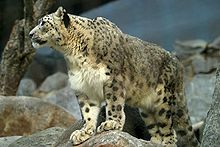
The Moscow Zoo exhibited the first captive snow leopard in 1872 that had been caught in Turkestan. In Kyrgyzstan, 420 live snow leopards were caught between 1936 and 1988 and exported to zoos around the world. The first captive bred snow leopard cubs were born in the 1990s in the Beijing Zoo.[49] The Snow Leopard Species Survival Plan was initiated in 1984; by 1986, American zoos held 234 individuals.[80]
Cultural significance
This section needs additional citations for verification. (May 2020) |

The snow leopard is widely used in heraldry and as an emblem in Central Asia. It has long been used as a political symbol, the Aq Bars ('White Leopard'), by Tatars, Kazakhs, and Bulgars. A snow leopard is depicted on the official seal of Almaty and on the former 10,000 Kazakhstani tenge banknote. A mythical winged Aq Bars is depicted on the national coat of arms of Tatarstan, the seal of the city of Samarqand, Uzbekistan and the old coat of arms of Nur-Sultan. In Kyrgyzstan, it has been used in highly stylized form in the modern emblem of the capital Bishkek, and the same art has been integrated into the badge of the Kyrgyzstan Girl Scouts Association. A crowned snow leopard features in the arms of Shushensky District in Russia.
It has also been declared the national animal of Pakistan.[81]

Symbol of Almaty, Kazakhstan

The coat of arms of Tatarstan
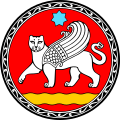
Seal of Samarqand, Uzbekistan

Old coat of arms of Nur-Sultan, Kazakhstan

Symbol of Bishkek, Kyrgyzstan

Coat of arms of Shushensky District, Krasnoyarsk Krai

Snow leopard on the reverse of the old 10,000-Kazakhstani tenge banknote
See also
- List of largest cats
References
- ^ Jump up to: a b c d e McCarthy, T.; Mallon, D.; Jackson, R.; Zahler, P. & McCarthy, K. (2017). "Panthera uncia". IUCN Red List of Threatened Species. 2017: e.T22732A50664030.
- ^ Janečka, J. E.; Jackson. R.; Yuquang, Z.; Diqiang, L.; Munkhtsog, B.; Buckley-Beason, V.; Murphy, W. J. (2008). "Population monitoring of snow leopards using noninvasive collection of scat samples: a pilot study". Animal Conservation. 11 (5): 401–411. doi:10.1111/j.1469-1795.2008.00195.x.
- ^ Wozencraft, W. C. (2005). "Species Uncia uncia". In Wilson, D. E.; Reeder, D. M. (eds.). Mammal Species of the World: A Taxonomic and Geographic Reference (3rd ed.). Johns Hopkins University Press. p. 548. ISBN 978-0-8018-8221-0. OCLC 62265494.
- ^ Allen, E. A. (1908). "English Doublets". Publications of the Modern Language Association of America. New Series 16. 23 (1): 184–239. doi:10.2307/456687. JSTOR 456687.
- ^ Liddell, H. G. & Scott, R. (1940). "πάνθηρ". A Greek-English Lexicon (Revised and augmented ed.). Oxford: Clarendon Press.
- ^ Schreber, J. C. D. (1777). "Die Unze". Die Säugethiere in Abbildungen nach der Natur mit Beschreibungen. Erlangen: Wolfgang Walther. pp. 386–387.
- ^ Gray, J. E. (1854). "The ounces". Annals and Magazine of Natural History. 2. 14: 394.
- ^ Ehrenberg, C. G. (1830). "Observations et données nouvelles sur le tigre du nord et la panthère du nord, recueillies dans le voyage de Sibérie fait par M.A. de Humboldt, en l'année 1829". Annales des sciences naturelles, Zoologie. 21: 387–412.
- ^ Horsfield, T. (1855). "Brief notices of several new or little-known species of Mammalia, lately discovered and collected in Nepal, by Brian Houghton Hodgson". The Annals and Magazine of Natural History: Including Zoology, Botany, and Geology. 2. 16 (92): 101–114. doi:10.1080/037454809495489.
- ^ Jump up to: a b Pocock, R. I. (1930). "The panthers and ounces of Asia. Part II. The panthers of Kashmir, India, and Ceylon". Journal of the Bombay Natural History Society. 34 (2): 307–336.
- ^ Jump up to: a b c Johnson, W. E.; Eizirik, E.; Pecon-Slattery, J.; Murphy, W. J.; Antunes, A.; Teeling, E. & O'Brien, S. J. (2006). "The late Miocene radiation of modern Felidae: a genetic assessment". Science. 311 (5757): 73–77. Bibcode:2006Sci...311...73J. doi:10.1126/science.1122277. PMID 16400146. S2CID 41672825.
- ^ Jump up to: a b c Davis, B. W.; Li, G. & Murphy, W. J. (2010). "Supermatrix and species tree methods resolve phylogenetic relationships within the big cats, Panthera (Carnivora: Felidae)" (PDF). Molecular Phylogenetics and Evolution. 56 (1): 64–76. doi:10.1016/j.ympev.2010.01.036. PMID 20138224.
- ^ Kitchener, A. C.; Driscoll, C. A. & Yamaguchi, N. (2016). "What is a Snow Leopard? Taxonomy, Morphology, and Phylogeny". In McCarthy, T. & Mallon, D. (eds.). Snow Leopards. Amsterdam, Boston, Heidelberg, London, New York: Academic Press. pp. 3–11. ISBN 9780128024966.
- ^ Kitchener, A. C.; Breitenmoser-Würsten, C.; Eizirik, E.; Gentry, A.; Werdelin, L.; Wilting, A.; Yamaguchi, N.; Abramov, A. V.; Christiansen, P.; Driscoll, C.; Duckworth, J. W.; Johnson, W.; Luo, S.-J.; Meijaard, E.; O’Donoghue, P.; Sanderson, J.; Seymour, K.; Bruford, M.; Groves, C.; Hoffmann, M.; Nowell, K.; Timmons, Z. & Tobe, S. (2017). "A revised taxonomy of the Felidae: The final report of the Cat Classification Task Force of the IUCN Cat Specialist Group" (PDF). Cat News (Special Issue 11): 69.
- ^ Medvedev, D. G. (2000). "Morfologicheskie otlichiya irbisa iz Yuzhnogo Zabaikalia" [Morphological differences of the snow leopard from Southern Transbaikalia]. Vestnik Irkutskoi Gosudarstvennoi Sel'skokhozyaistvennoi Akademyi [Proceedings of Irkutsk State Agricultural Academy]. 20: 20–30.
- ^ Janecka, J. E.; Zhang, Y.; Li, D.; Munkhtsog, B.; Bayaraa, M.; Galsandorj, N.; Wangchuk, T. R.; Karmacharya, D.; Li, J.; Lu, Z. & Uulu, K. Z. (2017). "Range-Wide Snow Leopard Phylogeography Supports Three Subspecies". Journal of Heredity. 108 (6): 597–607. doi:10.1093/jhered/esx044. PMID 28498961.
- ^ Senn, H.; Murray-Dickson, G.; Kitchener, A. C.; Riordan, P. & Mallon, D. (2018). "Response to Janecka et al. 2017". Heredity. 120 (6): 581–585. doi:10.1038/s41437-017-0015-4. PMC 5943311. PMID 29225352.
- ^ Janecka, J. E.; Janecka, M. J.; Helgen, K. M. & Murphy, W. J. (2018). "The validity of three snow leopard subspecies: response to Senn et al". Heredity. 120 (6): 586–590. doi:10.1038/s41437-018-0052-7. PMC 5943360. PMID 29434338.
- ^ Janecka, J. E.; Hacker, C.; Broderick, J.; Pulugulla, S.; Auron, P.; Ringling, M.; Nelson, B.; Munkhtsog, B.; Hussain, S.; Davis, B. & Jackson, R. (2020). "Noninvasive genetics and genomics shed light on the status, phylogeography, and evolution of the elusive Snow Leopard". In Ortega, J. & Maldonado, J. E. (eds.). Conservation Genetics in Mammals. Integrative Research Using Novel Approaches. Basel: Springer International Publishing. pp. 83–120. doi:10.1007/978-3-030-33334-8_5. ISBN 978-3-030-33334-8.
- ^ Korablev, M.; Poyarkov, A. D.; Karnaukhov, A. S.; Zvychaynaya, E. Y.; Kuksin, A. N.; Malykh, S. V.; Istomov, S. V.; Spitsyn, S. V.; Aleksandrov, D. Y.; Hernandez-Blanco, J. A. & Munkhtsog, B. (2021). "Large‑scale and fine‑grain population structure and genetic diversity of snow leopards (Panthera uncia Schreber, 1776) from the northern and western parts of the range with an emphasis on the Russian population" (PDF). Conservation Genetics. 22 (3): 397–410. doi:10.1007/s10592-021-01347-0.
- ^ Jump up to: a b Werdelin, L.; Yamaguchi, N.; Johnson, W. E. & O'Brien, S. J. (2010). "Phylogeny and evolution of cats (Felidae)". In Macdonald, D. W. & Loveridge, A. J. (eds.). Biology and Conservation of Wild Felids. Oxford, UK: Oxford University Press. pp. 59–82. ISBN 978-0-19-923445-5.
- ^ Mazák, J.H.; Christiansen, P.; Kitchener, A.C. & Goswami, A. (2011). "Oldest known pantherine skull and evolution of the tiger". PLOS ONE. 6 (10): e25483. Bibcode:2011PLoSO...625483M. doi:10.1371/journal.pone.0025483. PMC 3189913. PMID 22016768.
- ^ Tseng, Z. J.; Wang, X.; Slater, G. J.; Takeuchi, G. T.; Li, Q.; Liu, J. & Xie, G. (2014). "Himalayan fossils of the oldest known pantherine establish ancient origin of big cats". Proceedings of the Royal Society B: Biological Sciences. 281 (1774): 20132686. doi:10.1098/rspb.2013.2686. PMC 3843846. PMID 24225466.
- ^ Li, G.; Davis, B. W.; Eizirik, E. & Murphy, W. J. (2016). "Phylogenomic evidence for ancient hybridization in the genomes of living cats (Felidae)". Genome Research. 26 (1): 1–11. doi:10.1101/gr.186668.114. PMC 4691742. PMID 26518481.
- ^ Jump up to: a b Hemmer, H. (1972). "Uncia uncia" (PDF). Mammalian Species. 20 (20): 1–5. doi:10.2307/3503882. JSTOR 3503882. Archived from the original (PDF) on 2012-04-01.
- ^ Jump up to: a b c d e f g h Sunquist, M. & Sunquist, F. (2002). "Snow leopard Uncia uncia (Schreber, 1775)". Wild Cats of the World. Chicago: University of Chicago Press. pp. 377–394. ISBN 978-0-226-77999-7.
- ^ Christiansen, P. (2007). "Canine morphology in the larger Felidae: implications for feeding ecology". Biological Journal of the Linnean Society. 91 (4): 573–592. doi:10.1111/j.1095-8312.2007.00819.x.
- ^ Torregrosa, V.; Petrucci, M.; Pérez-Claros, J. A. & Palmqvist, P. (2010). "Nasal aperture area and body mass in felids: Ecophysiological implications and paleobiological inferences". Geobios. 43 (6): 653–661. doi:10.1016/j.geobios.2010.05.001.
- ^ Janecka, J.E.; Nielsen, S.S.; Andersen, S.D.; Hoffmann, F.G.; Weber, R.E.; Anderson, T.; Storz, J.F. & Fago, A. (2015). "Genetically based low oxygen affinities of felid hemoglobins: lack of biochemical adaptation to high-altitude hypoxia in the snow leopard". Journal of Experimental Biology. 218 (15): 2402–2409. doi:10.1242/jeb.125369. PMC 4528707. PMID 26246610.
- ^ Chadwick, D. H. (2008). "Out of the Shadows". National Geographic. Retrieved 2010-01-29.
- ^ Hast, M. H. (1989). "The larynx of roaring and non-roaring cats". Journal of Anatomy. 163: 117–121. PMC 1256521. PMID 2606766.
- ^ Weissengruber, G. E.; Forstenpointner, G.; Peters, G.; Kübber-Heiss, A.; Fitch, W. T. (2002). "Hyoid apparatus and pharynx in the lion (Panthera leo), jaguar (Panthera onca), tiger (Panthera tigris), cheetah (Acinonyx jubatus) and domestic cat (Felis silvestris f. catus)". Journal of Anatomy. 201 (3): 195–209. doi:10.1046/j.1469-7580.2002.00088.x. PMC 1570911. PMID 12363272.
- ^ Jump up to: a b Heptner, V. G.; Sludskij, A. A. (1992) [1972]. "Snow Leopard, Ounce [Irbis]". Mlekopitajuščie Sovetskogo Soiuza. Moskva: Vysšaia Škola [Mammals of the Soviet Union. Volume II, Part 2. Carnivora (Hyaenas and Cats)]. Washington DC: Smithsonian Institution and the National Science Foundation. pp. 276–319.
- ^ Jump up to: a b McCarthy, T. M. & Chapron, G. (2003). Snow Leopard Survival Strategy (PDF). Seattle, USA: International Snow Leopard Trust and Snow Leopard Network.
- ^ Simms, A.; Moheb, Z.; Salahudin; Ali, H.; Ali, I.; Wood, T. (2011). "Saving threatened species in Afghanistan: snow leopards in the Wakhan Corridor". International Journal of Environmental Studies. 68 (3): 299–312. doi:10.1080/00207233.2011.577147. S2CID 96170915.
- ^ Jackson, R. & Ahlborn, G. (1988). "Observations on the ecology of snow leopard in west Nepal" (PDF). In Freeman, H. (ed.). Proceedings of the Fifth International Snow Leopard Symposium. India: International Snow Leopard Trust. pp. 65–97.
- ^ Jackson, R. (1996). Home Range, Movements and Habitat Use of Snow Leopard in Nepal (PhD). London: University of London.
- ^ Jump up to: a b c d e f g h i j Johansson, Ö.; Rauset, G. R.; Samelius, G.; McCarthy, T.; Andrén, H.; Tumursukh, L. & Mishra, C. (2016). "Land sharing is essential for snow leopard conservation" (PDF). Biological Conservation. 203 (203): 1–7. doi:10.1016/j.biocon.2016.08.034.
- ^ Das, S.; Manna, S.; Ray, S.; Das, P.; Rai, U.; Ghosh, B. & Sarkar, M. P. (2019). "Do Urinary Volatiles Carry Communicative Messages in Himalayan Snow Leopards [Panthera uncia, (Schreber, 1775)]?". In Buesching, C. (ed.). Chemical Signals in Vertebrates. 14. Cham: Springer. pp. 27–37. doi:10.1007/978-3-030-17616-7_3. ISBN 978-3-030-17615-0.
- ^ Fox, J. L. & Chundawat, R. S. (1988). "Observations of snow leopard stalking, killing and feeding behavior" (PDF). Mammalia. 52 (1): 137–140.
- ^ Johansson, Ö.; McCarthy, T.; Samelius, G.; Andrén, H.; Tumursukh, L. & Mishra, C. (2015). "Snow leopard predation in a livestock dominated landscape in Mongolia" (PDF). Biological Conservation. 184: 251–258. doi:10.1016/j.biocon.2015.02.003.
- ^ Lyngdoh, S.; Shrotriya, S.; Goyal, S. P., Clements, H.; Hayward, M. W. & Habib, B. (2014). "Prey preferences of the snow leopard (Panthera uncia): regional diet specificity holds global significance for conservation". PLoS ONE. 9 (2): e88349. Bibcode:2014PLoSO...988349L. doi:10.1371/journal.pone.0088349. PMC 3922817. PMID 24533080.
- ^ Jump up to: a b Shehzad, W.; McCarthy, T. M.; Pompanon, F.; Purevjav, L.; Coissac, E.; Riaz, T. & Taberlet, P. (2012). "Prey Preference of Snow Leopard (Panthera uncia) in South Gobi, Mongolia". PLOS ONE. 7 (2): e32104. Bibcode:2012PLoSO...732104S. doi:10.1371/journal.pone.0032104. PMC 3290533. PMID 22393381.
- ^ Khatoon, R.; Hussain, I.; Anwar, M. & Nawaz, M. A. (2017). "Diet selection of snow leopard (Panthera uncia) in Chitral, Pakistan". Turkish Journal of Zoology. 41 (41): 914–923. doi:10.3906/zoo-1604-58.
- ^ Pal, R.; Bhattacharya, T. & Sathyakumar, S. (2020). "Woolly flying squirrel Eupetaurus cinereus: A new addition to the diet of snow leopard Panthera uncia" (PDF). Journal of the Bombay Natural History Society. 117. doi:10.17087/jbnhs/2020/v117/142056.
- ^ Macri, A. M. & Patterson-Kane, E. (2011). "Behavioural analysis of solitary versus socially housed snow leopards (Panthera uncia), with the provision of simulated social contact". Applied Animal Behaviour Science. 130 (3–4): 115–123. doi:10.1016/j.applanim.2010.12.005.
- ^ Johansson, Ö.; Ausilio, G.; Low, M.; Lkhagvajav, P.; Weckworth, B. & Sharma, K. (2021). "The timing of breeding and independence for snow leopard females and their cubs". Mammalian Biology. 101 (2): 173–180. doi:10.1007/s42991-020-00073-3.
- ^ Pacifici, M.; Santini, L.; Di Marco, M.; Baisero, D.; Francucci, L.; Grottolo Marasini, G.; Visconti, P. & Rondinini, C. (2013). "Generation length for mammals". Nature Conservation (5): 87–94.
- ^ Jump up to: a b c Dexel, B. (2002). The Illegal Trade in Snow Leopards – A Global Perspective. Berlin: German Society for Nature Conservation.
- ^ Jump up to: a b Theile, S. (2003). Fading footprints; the killing and trade of snow leopards (PDF). Cambridge, UK: TRAFFIC International. ISBN 1-85850-201-2.
- ^ Nowell, K.; Li, J.; Paltsyn, M. & Sharma, R.K. (2016). An Ounce of Prevention: Snow Leopard Crime Revisited (PDF). Cambridge, UK: TRAFFIC International. ISBN 978-1-85850-409-4.
- ^ Jump up to: a b Maheshwari, A.; Niraj, S. K.; Sathyakumar, S.; Thakur, M. & Sharma, L. K. (2016). "Snow leopard illegal trade in Afghanistan: A rapid survey". Cat News (64): 22–23.
- ^ Forrest, J. L.; Wikramanayake, E.; Shrestha, R.; Areendran, G.; Gyeltshen, K.; Maheshwari, A.; Mazumdar, S.; Naidoo, R.; Thapa, G. J. & Thapa, K. (2012). "Conservation and climate change: Assessing the vulnerability of snow leopard habitat to treeline shift in the Himalaya" (PDF). Biological Conservation. 150 (1): 129–135. doi:10.1016/j.biocon.2012.03.001.
- ^ Moheb, Z. & Paley, R. (2016). "Central Asia: Afghanistan". In McCarthy, T. & Mallon, D. (eds.). Snow Leopards: Biodiversity of the World: Conservation from Genes to Landscapes. Amsterdam, Boston, Heidelberg, London, New York: Academic Press. pp. 409–417. ISBN 9780128024966.
- ^ Jump up to: a b Lham, D.; Thinley, P.; Wangchuk,S.; Wangchuk, N.; Lham, K.; Namgay, T.; Tharchen, L. & Wangchuck, T. (2016). National Snow Leopard Survey of Bhutan – Phase II: Camera Trap Survey for Population Estimation (Report). Thimphu, Bhutan: Wildlife Conservation Division, Department of Forests and Park Services.
- ^ Liu, Y.; Weckworth, B.; Li, J.; Xiao, L.; Zhao, X. & Lu, Z. (2016). "China: The Tibetan Plateau, Sanjiangyuan Region". In McCarthy, T. & Mallon, D. (eds.). Snow Leopards: Biodiversity of the World: Conservation from Genes to Landscapes. Amsterdam, Boston, Heidelberg, London, New York: Academic Press. pp. 513–521. ISBN 9780128024966.
- ^ Jump up to: a b Bhatnagar, Y. V.; Mathur, V. B.; Sathyakumar, S.; Ghoshal, A.; Sharma, R. K.; Bijoor, A.; Raghunath, R.; Timbadia, R. & Lal, P. (2016). "South Asia: India". In McCarthy, T. & Mallon, D. (eds.). Snow Leopards: Biodiversity of the World: Conservation from Genes to Landscapes. Amsterdam, Boston, Heidelberg, London, New York: Academic Press. pp. 457–470. ISBN 9780128024966.
- ^ Loginov, O. (2016). "Central Asia: Kazakhstan". In McCarthy, T.; Mallon, D. (eds.). Snow Leopards: Biodiversity of the World: Conservation from Genes to Landscapes. Amsterdam, Boston, Heidelberg, London, New York: Academic Press. pp. 427–430. ISBN 9780128024966.
- ^ Daveltbakov, A.; Rosen, T.; Anarbaev, M.; Kubanychbekov, Z.; Jumabai uulu, K.; Samanchina, J. & Sharma, K. (2016). "Central Asia: Kyrgyzstan". In McCarthy, T. & Mallon, D. (eds.). Snow Leopards. Amsterdam, Boston, Heidelberg, London, New York: Academic Press. pp. 419–425. ISBN 9780128024966.
- ^ Munkhtsok, B.; Purevjav, L.; McCarthy, T. & Bayrakçismith, R. (2016). "Northern Range: Mongolia". In McCarthy, T. & Mallon, D. (eds.). Snow Leopards. Amsterdam, Boston, Heidelberg, London, New York: Academic Press. pp. 493–500. ISBN 9780128024966.
- ^ Ale, S.; Shah, K. B.; Jackson, R. M. & Rosen, T. (2016). "South Asia: Nepal". In McCarthy, T. & Mallon, D. (eds.). Snow Leopards: Biodiversity of the World: Conservation from Genes to Landscapes. Amsterdam, Boston, Heidelberg, London, New York: Academic Press. pp. 471–479. ISBN 9780128024966.
- ^ Khan, A. (2016). "South Asia: Pakistan". In McCarthy, T.; Mallon, D. (eds.). Snow Leopards: Biodiversity of the World: Conservation from Genes to Landscapes. Amsterdam, Boston, Heidelberg, London, New York: Academic Press. pp. 481–491. ISBN 9780128024966.
- ^ Paltsyn, M.; Poyarkov, A.; Spitsyn, S.; Kuksin, A.; Istomov, S.; Gibbs, J.P.; Jackson, R. M.; Castner, J.; Kozlova, S.; Karnaukhov, A. & Malykh, S. (2016). "Northern Range: Russia". In McCarthy, T. & Mallon, D. (eds.). Snow Leopards: Biodiversity of the World: Conservation from Genes to Landscapes. Amsterdam, Boston, Heidelberg, London, New York: Academic Press. pp. 501–511. ISBN 9780128024966.
- ^ Saidov, A.; Karimov, K.; Amirov, Z. & Rosen, T. (2016). "Central Asia: Tajikistan". In McCarthy, T. & Mallon, D. (eds.). Snow Leopards: Biodiversity of the World: Conservation from Genes to Landscapes. Amsterdam, Boston, Heidelberg, London, New York: Academic Press. pp. 433–437. ISBN 9780128024966.
- ^ Esipov, A.; Bykova, E.; Protas, Y. & Aromov, B. (2016). "Central Asia: Uzbekistan". In McCarthy, T. & Mallon, D. (eds.). Snow Leopards: Biodiversity of the World: Conservation from Genes to Landscapes. Amsterdam, Boston, Heidelberg, London, New York: Academic Press. pp. 439–448. ISBN 9780128024966.
- ^ Nowell, K.; Jackson, P. (1996). "Snow leopard, Uncia uncia". Wild cats: Status survey and conservation action plan. Gland, Switzerland: International Union for Conservation of Nature and Natural Resources. pp. 91–95. ISBN 9782831700458.
- ^ Kattel, B. & Bajiimaya, S. (1995). "Status and conservation of Snow Leopard in Nepal". In Jackson, R. & Ahmad, A. A. (eds.). Proceedings of the Eighth International Snow Leopard Symposium, 12–16 November 1995, Islamabad, Pakistan. Islamabad, Pakistan: International Snow Leopard Trust. pp. 21–27.
- ^ Paltsyn, M.Y.; Spitsyn, S.V.; Kuksin, A.N. & Istomov, S.V. (2012). Snow Leopard Conservation in Russia – Data for Conservation Strategy for Snow Leopard in Russia (Report). Krasnoyarsk: WWF Russia.
- ^ Riordan, P. & Kun, S. (2010). "The Snow Leopard in China". Cat News (Special Issue 5): 14–17.
- ^ Esipov, A.; Bykova, E.; Protas, Y. & Aromov, B. (2016). "Central Asia: Uzbekistan". In McCarthy, T. & Mallon, D. (eds.). Snow Leopards. Amsterdam, Boston, Heidelberg, London, New York: Academic Press. pp. 439–447. ISBN 9780128024966.
- ^ Jackson, R. (1998). "People-Wildlife Conflict Management in the Qomolangma Nature Preserve, Tibet" (PDF). In Wu Ning; D. Miller; Lhu Zhu; J. Springer (eds.). Tibet's Biodiversity: Conservation and Management. Proceedings of a Conference, August 30 – September 4, 1998. Tibet Forestry Department and World Wide Fund for Nature. pp. 40–46.
- ^ Liu, Y.; Weckworth, B.; Li, J.; Xiao, L.; Zhao, X. & Lu, Z. (2016). "China: The Tibetan Plateau, Sanjiangyuan Region". In McCarthy, T. & Mallon, D. (eds.). Snow Leopards. Amsterdam, Boston, Heidelberg, London, New York: Academic Press. pp. 513–521. ISBN 9780128024966.
- ^ Ming, M.; Feng, X.; Turghan, M. & Shoujin, Y. (2004). Report on Snow Leopard (Uncia uncia) Surveys in Tomur, Xinjiang, China (PDF). Xinjiang: Xinjiang Institute of Ecology and Geography, Chinese Academy of Sciences.
- ^ Alexander, J. S.; Shi, K.; Tallents, L. A. & Riordan, P. (2016). "On the high trail: examining determinants of site use by the Endangered snow leopard Panthera uncia in Qilianshan, China" (PDF). Oryx. 50 (2): 231–238. doi:10.1017/S0030605315001027. S2CID 88193382.
- ^ Mishra, C. (1997). "Livestock depredation by large carnivores in the Indian trans-Himalaya: conflict perceptions and conservation prospects" (PDF). Environmental Conservation. 24 (4): 338–343. doi:10.1017/S0376892997000441.
- ^ Devkota, B. P.; Silwal, T.; Shrestha, B. P.; Sapkota, A. P.; Lakhey, S. P. & Yadav, V. K. (2017). "Abundance of snow leopard (Panthera uncia) and its wild prey in Chhekampar VDC, Manaslu Conservation Area, Nepal". Banko Janakari. 27 (1): 11–20. doi:10.3126/banko.v27i1.18545.
- ^ Leki; Thinley, P.; Rajaratnam, R. & Shrestha, R. (2018). "Establishing baseline estimates of blue sheep (Pseudois nayaur) abundance and density to sustain populations of the vulnerable snow leopard (Panthera uncia) in Western Bhutan". Wildlife Research. 45 (1): 38–46. doi:10.1071/WR16218. S2CID 89745062.
- ^ Jamtsho, Y. & Katel, O. (2019). "Livestock depredation by snow leopard and Tibetan wolf: Implications for herders' livelihoods in Wangchuck Centennial National Park, Bhutan". Pastoralism. 9 (1): 1. doi:10.1186/s13570-018-0136-2.
- ^ "Global Snow Leopard Conservation Forum". World Bank. Retrieved 2021-04-17.
- ^ Wharton, D. & Freeman, H. (1988). "The Snow Leopard in North America: Captive Breeding Under the Species Survival Plan". In Freeman, H. (ed.). Proceedings of the Fifth International Snow Leopard Symposium. Seattle and Dehra Dun: International Snow Leopard Trust and Wildlife Institute of India. pp. 131–136.
- ^ "The Official Web Gateway to Pakistan". www.pakistan.gov.pk. Archived from the original on 2016-11-28. Retrieved 2016-10-23.
Further reading
- Jackson, R.; Hillard, D. (June 1986). "Tracking the Elusive Snow Leopard". National Geographic. Vol. 169 no. 6. pp. 793–809. OCLC 643483454.
- Janczewski, D. N.; Modi, W. S.; Stephens, J. C.; O'Brien, S. J. (July 1995). "Molecular Evolution of Mitochondrial 12S RNA and Cytochrome b Sequences in the Pantherine Lineage of Felidae". Molecular Biology and Evolution. 12 (4): 690–707. doi:10.1093/oxfordjournals.molbev.a040232. PMID 7544865.
External links
| Wikimedia Commons has media related to: Panthera uncia (category) |
- "The Snow Leopard Network". Snow Leopard Network.
- "Ensuring Snow Leopard survival and conserving mountain landscapes by expanding environmental awareness and sharing innovative practices through community stewardship and partnerships". Snow Leopard Conservancy.
- "Snow Leopard Program". Panthera.
- "Snow Leopard". IUCN/SSC Cat Specialist Group.
- IUCN Red List vulnerable species
- Apex predators
- Big cats
- Fauna of East Asia
- Fauna of the Himalayas
- Fauna of Siberia
- Felids of Asia
- Felids of India
- Mammals described in 1775
- Mammals of Central Asia
- Mammals of South Asia
- National symbols of Pakistan
- Panthera
- Symbols of Himachal Pradesh
- Vulnerable animals
- Vulnerable biota of Asia








